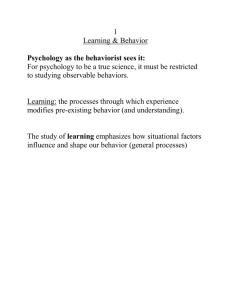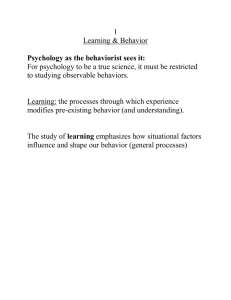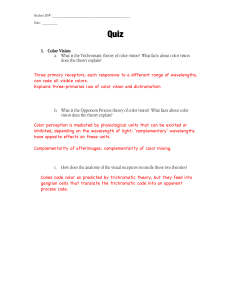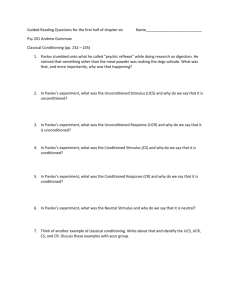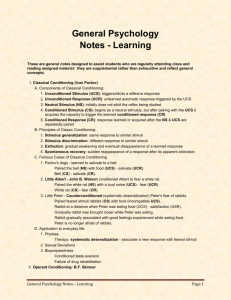Chapter 5 Powerpoint 1
advertisement
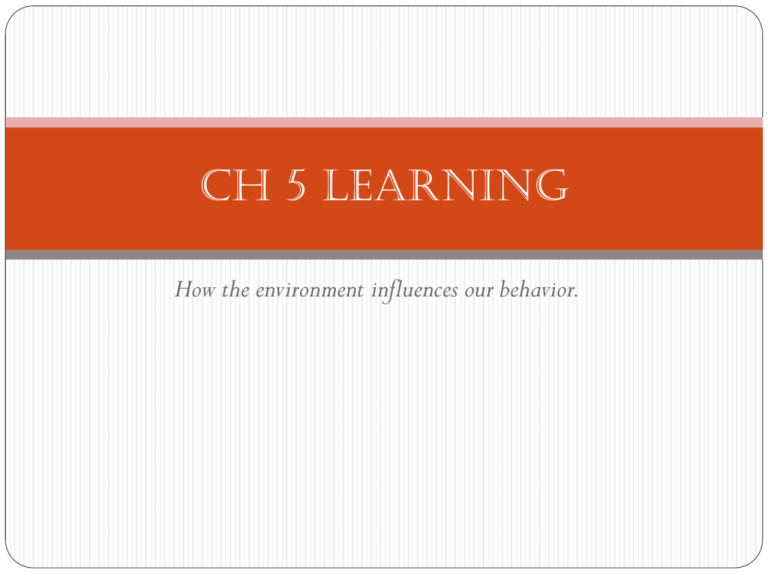
Ch 5 learning How the environment influences our behavior. learning More than just picking up knowledge or a skill: A semi-permanent change in behavior brought by experience or practice The four pillars of learning Classical Conditioning – gaining automatic connections Operant Conditioning – repeating what works, avoiding what doesn’t Social Learning – being influenced by those we admire Classical Conditioning Learning to make an involuntary (reflex) respond to a stimulus other than the original natural stimulus Reflex- involuntary response Unconditioned stimulus UCS- a naturally occurring stimulus that leads to a reflex Unconditioned response UCR- an involuntary (reflex) response to a naturally occurring or UCS Classical Conditioning Neutral Stimulus NS- Stimulus that has no affect on the desired response Conditioned Stimulus CS- Stimulus that becomes able to produce a learned reflex response paired with the original unconditioned stimulus Conditioned Response CR-Learned reflex response to a conditioned stimulus background It all started with Ivan Pavlov and his study of the digestive system Research based on work with animals Studied the automatic connection between food (meat) in the mouth and the flow of digestive juices UCS (meat in mouth) > UCR (saliva) The big idea Start with an unconditioned reflex – an automatic connection between a stimulus and a response (meat>saliva) Big idea part 2 Develop new automatic responses by repetitively pairing an originally neutral stimulus with an UCS Let’s say that a different way An air puff in the eye (UCS) will always make us blink (UCR) Flashing a red card won’t But if we repetitively flash the red card, shortly followed by the air puff, eventually, Just flashing the red card will make us blink ! examples That particular corner at your high school The torturer’s black shoes The whistling of a V1 “shrieker” The song from that certain summer that reminds you of ….. Smell of food your grandma made Stimulus Generalization Other stimuli that is similar can lead to the same response Stimulus Discrimination When a person/animal is able to learn to respond different stimuli in different ways Extinction and Recovery When the response “Dies Out” Remove the reinforcement CS and the CR will weaken and disappear Spontaneous Recovery The CR can briefly reappear when the original CS returns Will be weak and short lived Unraveling the connection In CC, extinction takes place when we repeatedly present the CS without the UCS following it More perspectives CC prepares us for significant events by identifying events that commonly predict them Gives us advance warning of upcoming threats and opportunities The more unfamiliar the CS or the more powerful the UCS the faster the CR takes Other aspects The process that establishes or strengthens a CR is called acquisition A CS can even be a thought All together now First we build the CS>CR connection through acquisition, Then we unravel it through extinction, If we then stop presenting the CS for a while, once we resume its use, The CR will return, but not for long, unless it is again paired with the UCS Extending the connection The CR can occur even without presentation of the exact CS which formed it, if the new CS is similar enough Stimulus generalization – the extension or broadening of a CR from the original CS to another, similar stimulus The more similar the entire setting is, the more likely the new connection will form Narrowing connections If differing stimuli, although quite similar to the CS, are never, or rarely, followed by the UCS, then the CR will not emerge Stimulus discrimination – differing responses to differing stimuli that have been followed by differing events Is it just timing? The concept of blocking If a CS/CR link has been established, pairing a new CS will not work no matter how hard you may try Conditioned taste aversion The power of prediction It’s reliability that counts, the CS’ ability to accurately and consistently predict the UCS. The UCS must be more likely to occur after the CS. The big picture CC involves visceral reactions involving the sympathetic nervous system – you feel it in your gut. It prepares us for important challenges and threats. But it does not tell us what to do. The next step For how we learn voluntary, planned behaviors, we turn to operant conditioning.
